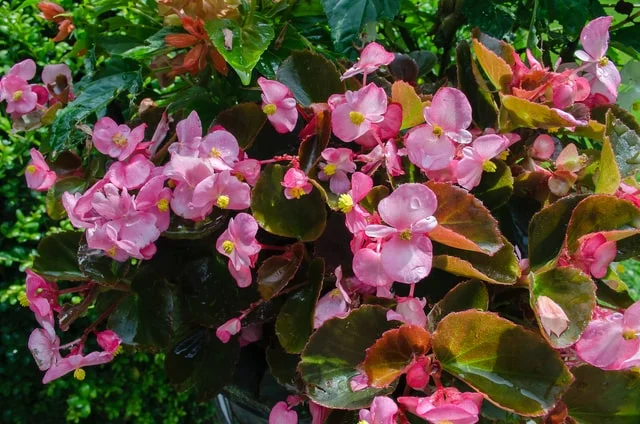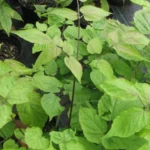Table of Contents
How to Care For Your Wax Begonia
Wax Begonia’s are an annual known for their ruddy tinged leaves and hearty, long-lasting blooms even in the face of summer. While they may not be as instantly recognizable as a rose, they are nonetheless a versatile and attractive plant that can easily be grown indoors or out.
If you want to learn more about Wax Begonia, how to plant them, and how to best care for them, be sure to read on in our ultimate guide to Wax Begonia below.
A Brief History of Wax Begonia
Begonia cucullata, or Wax Begonia has one of the more interesting taxonomical histories of any plant. A part of the Begonia species, these plants are usually found in tropical climates and although known for their beautiful blooms they can be thought of as common or everyday within their native ranges of South America.
Begonia cucullata’s epithet means “hooded” and was named so because the naturalist Carl Ludwig Willdenow (1765-1812), had described this specific species of flowers as such in 1805.
Appearance and Characteristics of Wax Begonia
Wax Begonia can also be referred to as Semperflorens Cultorum Group which means ever-blooming flowers cultivated in lands and gardens. They are prized as an annual that gardeners can use to fill edgings, containers and use as ground cover.
They are compact and bushy plants which are often recognized by their darker green and red hued leaves and that are also glossy and crenated in nature.
They produce steady blooms throughout their growing season, which falls between May and October in most climates. Their flowers are not dissimilar to a rose in appearance and come in single or double petal varieties in pink, white, or red.
Some varieties have been bred to be able to display two colors simultaneously.
Planting your Wax Begonia
Before planting your Wax Begonia, you will need to decide if you wish to grow it outdoors or indoors as a houseplant.
Consider the following when making your decision:
Wax Begonia Grown Outdoors
Although a tropical plant, Wax Begonia can actually be grown in USDA climate zones 8b-11.
When grown outdoors, most varieties of Wax Begonia can tolerate a variable amount of sunshine, somewhere between full sun and part shade. In warmer climates it will prefer dappled shade.
The plant is known for its ability to withstand hot and humid summers.
Wax Begonia is commonly used outdoors as ground cover due to its ability to rapidly propagate and tolerance to shade.
When grown in colder climates Wax Begonia can be thought of, and treated as, an annual. It may last in the landscape for several years when treated as such.
Wax Begonia will be happiest planted in beds with quick draining soils that are well mulched.
It is important to remember that the species is a prodigious spreader, and in fact is treated as an invasive species in parts of Florida and Georgia.
It mainly propagates itself through its plentiful seeds and is not thought to spread much by way of its root system, though it is capable of doing so.
Wax Begonia Grown Indoors
Wax Begonia can be cultivated indoors and be expected to live at least five years with proper care.
The plant will require light from a south- or east-facing window.
Make sure that you pot your plant in at least 12-inches of space.
When grown in a container your plant can be brought outside for summer and cut back and brought inside to overwinter.
Wax Begonia grown indoors should be kept away from moisture so that they don’t develop any fungus or mildew.
Grown indoors the plants only require a mild monthly fertilization that can be given in place of a watering.
They typically thrive in regular indoor temperatures between 65- and 80-degrees Fahrenheit.
How to plant your Wax Begonia Outdoors:
Planting your Wax Begonia is a simple process that requires only a little time and pre-planning to ensure success.
Keep in mind the following when planting your Wax Begonia:
1) When considering a location for your Wax Begonia, remember that they do best with morning sun, but can also tolerate more sunshine if they are kept properly moist, yet not wet.
2) As mentioned above, these plants do not tolerate staying wet well, be sure your soil is a fast-draining mix.
3) You will want to plant your Wax Begonia as soon as possible after purchasing them, but be sure that the last chance of frost has passed, as they are tender to the cold.
4) Your Wax Begonia can be planted along with most other annuals with no adverse reactions, just be sure to give each plant at least 12-inches of space.
5) Dig a hole at least six inches deep, break up the roots of your plant if necessary, and place the plant in the hole.
6) Cover roots with dirt, but importantly, if your Wax Begonia hasn’t reached full maturity, do not yet cover it with mulch.
7) Water down your plant and you’re done!
Planting a Wax Begonia indoors is even easier. Simply find a suitable container and follow steps 5-7, remembering to place your plant in a south- or east-facing window to ensure adequate sun.
Caring for your Wax Begonia
Watering Recommendations
The best advice for watering a Wax Begonia is to be more fearful of overwatering as opposed to under watering your plant. This is because Wax Begonia’s that are left in water are prone to root rot and developing fungal issues.
Grown indoors they require watering approximately twice a week. When grown outdoors the frequency of your watering schedule will largely be dictated by the local climate, but when in doubt allow for the topsoil to crack and dry completely before watering your Wax Begonia again.
Fertilizer Recommendations
Wax Begonia require multiple treatments of fertilizer a year. For best results, use a water soluble, slow-release fertilizer.
If you find your plants grow too much after fertilization, feel free to cut them back manually along with lessening the amount of fertilizer you use.
When grown indoors you can fertilize your Wax Begonia approximately twice a month with regular houseplant fertilizer.
Pruning Recommendations
Pruning is not normally a necessary part care for a Wax Begonia, as most varieties are self-cleaning. This means that their flowers fall off of their own accord.
If you wish to encourage further flower growth, or to better contour your plant’s shape, feel free to prune or dead head spent flowers, though as mentioned above, this isn’t strictly necessary.
How to Propagate Wax Begonia
While not a necessarily part of routine care for a Wax Begonia, the plants can nonetheless be propagated using four distinct methods.
You may make a cutting of either the leaf or stem of a Wax Begonia, which can be potted in ordinary perlite, potting soil. If taking the cutting from a stem, be sure to use a healthy stalk for your cutting.
If you are attempting to make a cutting from a leaf be sure to choose one with a prominent vein for the greatest chance of success. For either cutting method be sure to keep your specimens in a cool yet humid environment until they manage to take root.
You may also be able to propagate your Wax Begonia by simply dividing your plant and placing the newly separated portion into sterile potting soil. You will know that the separation has been a success when you begin to see new growth.
Lastly you can also produce seedlings by collecting your plant’s own seeds. This is accomplished by collecting them as they fall and placing them in a sterile planting medium around January.
Do not cover the seeds deeply and store in warm dry area. Water the seeds sparingly until shoots sprout. Transfer seedlings outdoors after the last threat of frost has passed and plant as you would conventionally.
Extra Tips For Wax Begonia Care
Pests and Blight
Wax Begonia are resistant to most common pests and blight. They are a particularly good option for those that struggle with rabbit infestations in their gardens, as the plant is toxic to them.
If insects such as mealybugs appear on your plant, they can be manually removed, and the plant treated with a mild detergent.
If you notice fuzz or mold on your plants, carefully remove it, and try to increase the space between stems and keep your plants as dry as possible.
Photo by Robin Jonathan Deutsch on Unsplash



